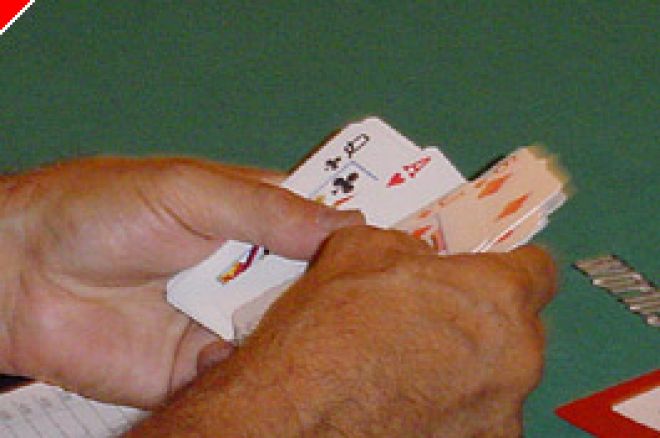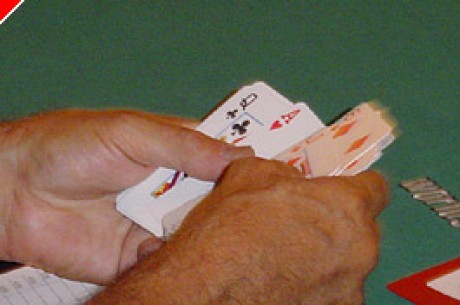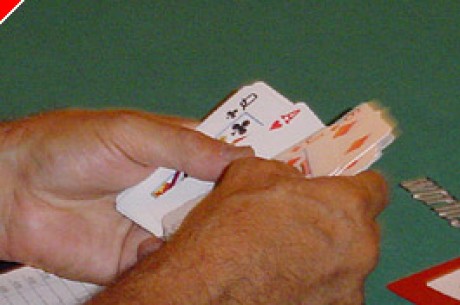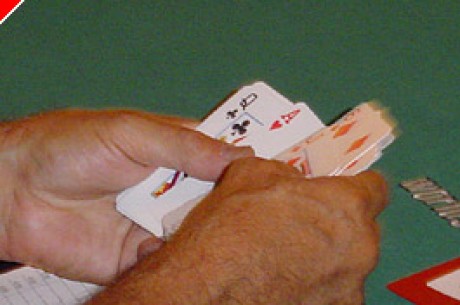Stud Strategy - Drafting and Poker

There's a concept applicable to stud poker that comes from bicycle racing. It's useful against moderately good opponents who know the importance of aggression. I call it "poker drafting".
In the bike racing it works like this. One bicyclist deliberately gets right behind another - not because he can't pass his opponent but to conserve his own energy. The lead cyclist cuts through the air, expending energy in so doing, while the follower rides in his wake - taking advantage of the slip stream that his leading opponent creates.
The idea is to draft behind an opponent until a moment when, energy saved, one can then burst into high gear, passing the opponent right at the end of the race. The sudden burst of speed surprises the lead cyclist when he is most tired from having lead the race up until that point. The lead cyclist is passed in a burst of energy at just the time when he is beginning to tire from having lead the whole race.
The same can be done in poker - though again I don't recommend this for beginning players against other inexperienced or otherwise bad players.
When you have a hand that you are nearly certain is well in the lead, but your opponent has taken the lead in betting or raising, don't challenge him for the lead by raising immediately. Rather, follow behind him as he continues to lead bet through the following rounds of betting - only coming out to overtake him with your aggression when he is unaware and, you hope, unable to concede the hand to you.
Similarly, if your opponent tends to try to steal the antes with the highest card on the board, but you have him beat, don't' dispel him or discourage him from his aggression. Induce him to continue to do so by passively calling along rather than by raising. Lull him into a false sense of security with your inaction.
Here's an example of this ploy. Suppose you have pocket Aces. Your opponent, in front of you, has a King showing and raises the bring in. It is surely tempting to swat him away with a re-raise. That's the most direct move - and probably the one you want to follow most of the time. Aces aren't a sure winner after all. And it's usually a good idea to force an opponent with a weaker hand to pay for the privilege of chasing your hand. You're usually not strong enough with just a pair of Aces to withstand the improvement of other players. And so the typical play is the reraise - driving out all other opponents and happy to win the pot right there from the raising King.
But this is a deceptive play. It's meant as an occasional change of pace from your typical play. Rather than reraise just call. You want to do this when you are reasonably certain that the hand will be played heads up. So if you're in a tight game it may be appropriate. Similarly, you need to know your opponent. He needs to be someone who tends to push the betting whether or not he's on a bluff or semi-bluff on Third Street. Ideally, you want an opponent who might continue to bet as a bluff as the hand progresses - hoping that you'll fold on Fourth or Fifth when he continues to bet.
So let him remain unchallenged by you with your wired pair. Same on Fourth Street. If he's high - as he is likely to be - and if he bets, just follow behind - letting him cut through the air so to speak as you follow in his wake. This is, in a sense, a slow play, but it is a special kind of slow play designed to take advantage of an opponent who might just continue to bet his high hand until he faces resistance. You don't want to offer him that resistance too soon.
If both of your hands continue to be unimproved and if he continues to lead bet (as oppose to check) you will continue to call him until Sixth Street, at which time you will raise him. You're happy to take the pot right there with just your Aces. But if he continues to call you, you're not disappointed either as you expect to be in the lead and will be likely to win an extra large bet this way.
The idea is to take advantage of the natural inclination of an opponent who is aggressive in the face of passivity. I've often found that players will continue to bluff at me as well when I assume this pose of weakness. But as soon as I show any strength by returning fire, they concede their bluff. By delaying my aggression I am inducing them to make the wrong play of bluffing.
Again, you have to be careful with this move. It doesn't work with more than one opponent, as there are just too many ways for multiple opponents to bypass you as you are holding back on your aggression. Better to limit the field with a re-raise most of the time if you're not pretty sure, either because of your position or because of the type of player you're against combined with their up cards, that they will leave you in a heads up battle.
I've found that adding this poker drafting to my repertoire of poker moves leaves my more observant opponents uncertain about my passivity when they see it. Sometimes when I check or just call, I have a drawing hand and just want a free card. By unexpectedly drafting from time to time and raising doubts about whether I'm just trying to seduce him into lead betting his second best hand I am also causing him to occasionally check to me when I want him to check - when I am on a draw. In so doing he is making a mistake - a mistake that eventually adds to my bottom line.
Ed Note: Great stud action always at Pacific Poker








